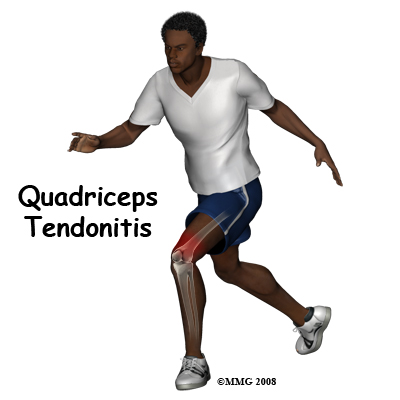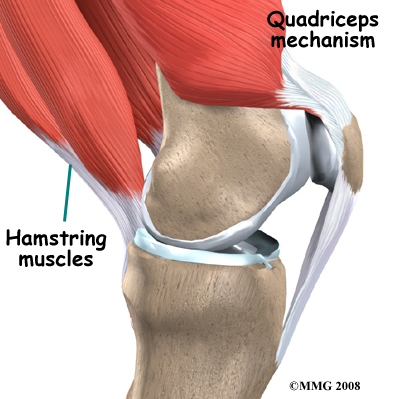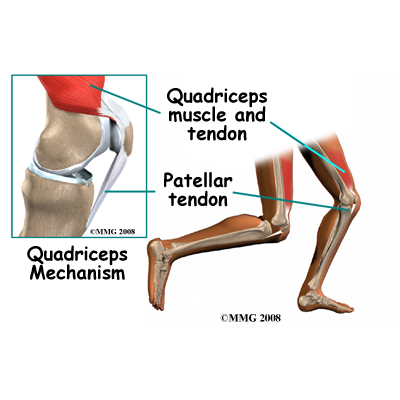What treatment options are available?
Nonsurgical Rehabilitation
Quadriceps tendonitis is usually self-limiting. That means the condition will run its course and resolve with the appropriate rest, activity modification, and physiotherapy. Recurrence of the problem is common for patients who fail to let the quadriceps tendon recover fully before resuming training or other aggravating activities.
The initial aim of treatment for acute quadriceps tendonitis at Emerald Hills Physio & Sports Clinic is to decrease the inflammation and pain in the knee. Simply icing your knee can assist with the inflammation and relieve a great deal of the pain. In cases of chronic tendonitis, heat may be more useful in decreasing pain. Your physiotherapist may also use electrical modalities such as ultrasound or interferential current to help decrease the pain and control the amount of inflammation. Some mild inflammation is actually needed in order for the injury to heal. Massage, especially for the quadriceps muscle, may also be helpful.
Medication to ease the pain or inflammation can often be very beneficial in the overall treatment of quadriceps tendonitis. Your physiotherapist may suggest you see your doctor to discuss the use of anti-inflammatories or pain-relieving medications in conjunction with your physiotherapy treatment. Your physiotherapist may even liaise directly with your doctor to obtain their advice on the use of medication in your individual case.
As inflammation of the quadriceps tendon most often occurs due to repetitive activity, rest is an important part of the treatment. ‘Relative rest’ is a term used to describe a process of rest-to-recovery based on the severity of symptoms. If you are experiencing pain while doing nothing (resting) it means the injury is more severe and your physiotherapist will advise a period of strict rest and possibly even a short time of immobilization in a splint or brace to prevent any repetitive knee flexion/extension. When pain is no longer present at rest, then a gradual increase in activity is permitted so long as there is no return in resting pain.
Once the initial pain and inflammation has calmed down, your physiotherapist will focus on improving the flexibility, strength, and alignment around the knee joint and the entire lower extremity. Static stretches to increase the flexibility of the muscles and tissues around the knee (particularly the quadriceps and iliotibial band on the outside of the knee) will be prescribed by your physiotherapist early on in your treatment. Again, any tightness in the muscles or tissues around the knee can increase the pull on the quadriceps tendon or affect alignment during walking, running or jumping so it is important to address this immediately. Dynamic stretching (rapid motions that stretch the tissues quickly) will also be taught and will be incorporated into your rehabilitation exercise routine as part of your warm-up once you return to doing more aggressive physical activity. Dynamic stretches are used to prepare the tissues for activity whereas static stretches focus more on gaining flexibility.
Strength imbalances will also affect the alignment of the knee and can cause muscles to tighten. Your physiotherapist will determine which muscles in your individual case require the most strengthening. Strength in both the knee and the hip (which controls the knee position) are very important. When bending the knee, the quadriceps tendon is placed under load while it is stretching. This load can be tremendous especially when jumping or landing. In order to prepare the healing tendon to take this load, your physiotherapist will prescribe ‘eccentric’ muscle strengthening. Eccentric contractions occur as the muscle lengthens and the tendon is put under stretch. Bending your knee quickly into a squatting position and then stopping rapidly (drop squats) encourages the knee to adapt to the force that will eventually be needed to return to physical activity. When appropriate, weights can be added to simulate the increased body weight that the knee endures during running and jumping. Your physiotherapist may even ask you to do this exercise on a board slanting downwards (approximately 25 degrees) which has been shown to also increase the force through the tendon. In addition, an electrical muscle stimulator on the quadriceps may be used which encourages improved recruitment of the quadriceps muscle. All exercises should be completed with minimal or no pain and advancing the exercises should be done at the discretion of your physiotherapist as not to flare up the healing tendon.
In addition to stretching and strengthening the knee, bracing or taping the patella or the quadriceps tendon itself can help you do exercises and activities with less pain. Your physiotherapist can educate you on which brace would be most appropriate for you. Most braces for knee tendonitis problems are made of soft fabric, such as cloth or neoprene. These braces work by encouraging proper alignment of the patella in the femoral groove and/or by distributing the force on the quadriceps tendon which is, in turn, improves the functioning of the quadriceps mechanism. An alternative to bracing is the use of tape. Your physiotherapist can tape your knee for you and can also teach you how to do it for yourself. Taping is an easy and cost-effective way to determine if a brace will decrease your pain before actually investing in one. Patients commonly report less pain and improved function with both taping and bracing.
Proper alignment of your entire lower extremity is paramount to decreasing the overall stress that is placed on your quadriceps tendon. In addition to strengthening and stretching, foot orthotics may be useful to correct your foot position, which encourages proper alignment up the lower extremity chain. Your physiotherapist can advise you on whether orthotics would be useful for you, and also on where to purchase them.
A critical part of our treatment for quadriceps tendonitis at Emerald Hills Physio & Sports Clinic includes education on returning to physical activity. Bending and straightening your knee occurs often even in everyday activities such as walking or stair climbing so a quadriceps tendon that is recovering from injury can easily be re-aggravated. Returning to your normal physical activity at a graduated pace is crucial to avoid repetitive tendonitis pain or a chronic injury. Advice from your physiotherapist on the acceptable level of activity at each stage of your rehabilitation process will be invaluable, and will assist you in returning to your activities as quickly but as safely as possible.
With a well-planned rehabilitation program, adherence to suggested levels of rest and activity modification, and by addressing the intrinsic and extrinsic factors that are modifiable, most patients are able to return to their previous level of activity without recurring symptoms. If, however, your pain continues and does not respond to conservative treatment, your physiotherapist may refer you back to your doctor or to an orthopaedic surgeon so you may discuss whether surgery may be an option for treatment.
Emerald Hills Physio & Sports Clinic provides services for physiotherapy in Sherwood Park.
 Alignment or overuse problems of the knee structures can lead to strain, irritation, and/or injury of the quadriceps muscle and tendon. This produces pain, weakness, and swelling of the knee joint.
Alignment or overuse problems of the knee structures can lead to strain, irritation, and/or injury of the quadriceps muscle and tendon. This produces pain, weakness, and swelling of the knee joint.
 The patella (kneecap) is the moveable bone on the front of the knee. This unique bone is wrapped inside a tendon that connects the large muscles on the front of the thigh, the quadriceps muscles, to the lower leg bone.
The patella (kneecap) is the moveable bone on the front of the knee. This unique bone is wrapped inside a tendon that connects the large muscles on the front of the thigh, the quadriceps muscles, to the lower leg bone.
 Strength of the patellar tendon is in direct proportion to the number, size, and orientation of the collagen fibers that make up the tendon. Overuse is simply a mismatch between load or stress on the tendon and the ability of that tendon to distribute the force. If the forces placed on the tendon are greater than the strength of the structure, then injury can occur. Repeated microtrauma at the musculotendinous junction may overcome the tendon's ability to heal itself. As a result issue breakdown occurs triggering an inflammatory response that leads to tendonitis and even partial tears.
Strength of the patellar tendon is in direct proportion to the number, size, and orientation of the collagen fibers that make up the tendon. Overuse is simply a mismatch between load or stress on the tendon and the ability of that tendon to distribute the force. If the forces placed on the tendon are greater than the strength of the structure, then injury can occur. Repeated microtrauma at the musculotendinous junction may overcome the tendon's ability to heal itself. As a result issue breakdown occurs triggering an inflammatory response that leads to tendonitis and even partial tears.